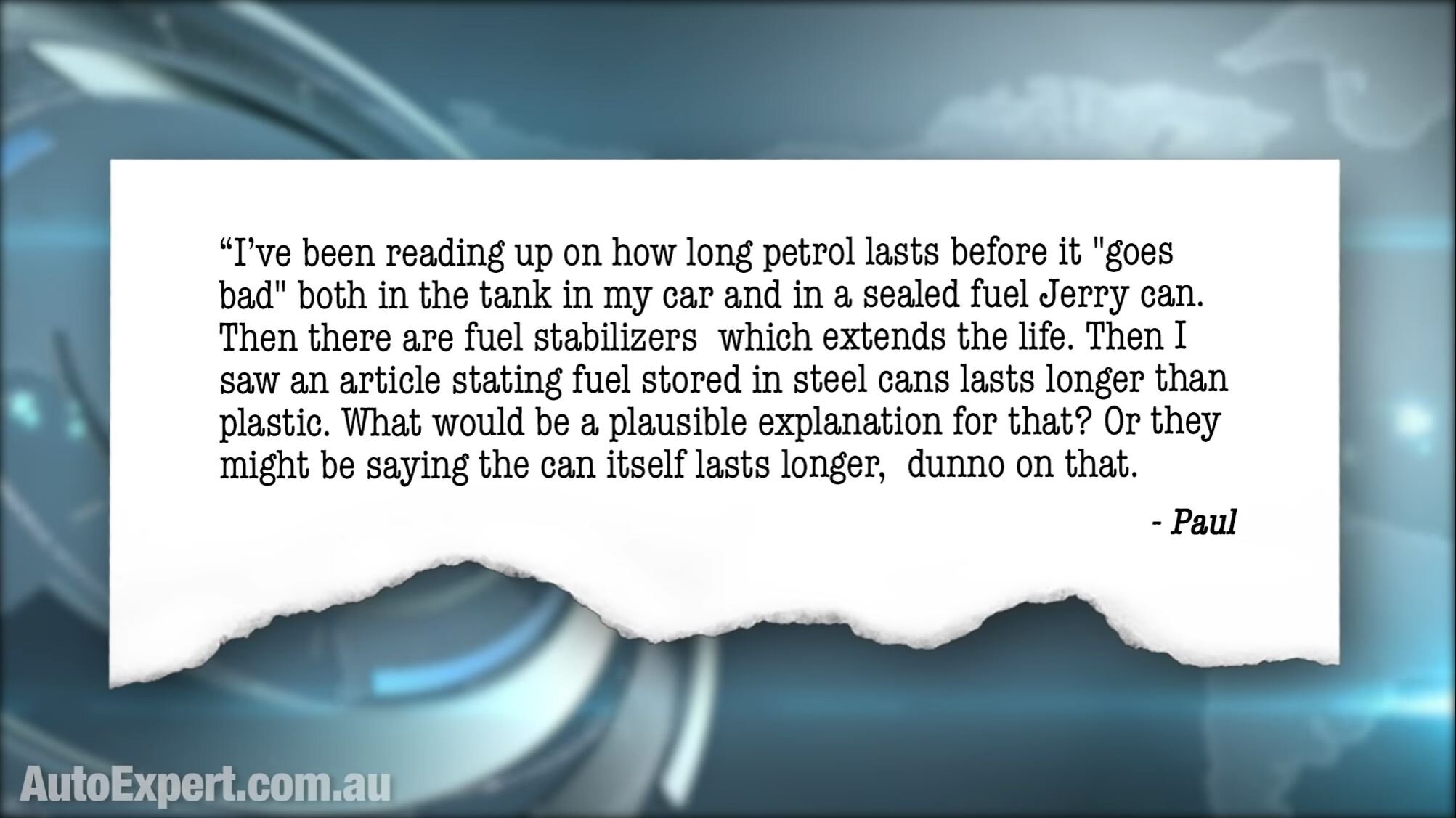How long does fuel last in your car before it goes bad?
Fuel ‘going bad’ and spoiling in the tank, going off, as it were. It’s all thanks to COVID and lockdown, right? But is this actually a real?
Been getting this question a lot, through COVID.
Lots of cars sitting around, not doing much driving. And certainly fuel - petrol and diesel - both change chemically over time.
But is this really something you need to worry about?
OK - so let’s bunk and de-bunk some of this, shall we?
First up, this garbage about: “I’ve been reading up about” something. If your car doesn’t have a problem, don’t try to solve it. Don’t go to Dr Google and invent something to obsess about, because non-problems don’t demand solutions.
The most-cited reference for these ‘fuel going off’ claims is a four-page PDF from BP, which you can fact check for yourself here >>.
First up, fuel is not the bread, the milk or the eggs. It doesn’t ‘go bad’ like fresh food; there’s no prawn heads in the hubcaps type of prank going on here - it’s totally different. Fuel degrades gradually over time - gradually - unless you do something horribly wrong.
Lots of ‘genius’ organizations out there like Suncorp and JD Power, etc, are trying to game Google’s search results by lunching off this BP reference, but in reality they pay cheap-arsed writers with no technical knowledge, so what you get is essentially a mixture of bullshit gibberish and fearmongering:
Suncorp there. That’s just indefensible bullshit. Like, how exactly are you expected to (quote) ‘look out for’ this ‘water separation’ or ‘sediment’ in the tank? X-ray vision? I really think it’s a bad idea for ordinary people, ie - not Superman - to pull fuel systems apart or attempt to look into a fuel tank, which is usually packed with highly combustible and otherwise hazardous vapour. So there’s that.
If there is a problem with your fuel it’s likely to present as a failure to start, or generally rough running, or hesitation under load, or an engine check light - that’s what I’d be looking out for. So, shame on you, Suncorp, for not knowing your arse from your elbow on this, but putting it out there anyway for website search indexing so that you can get more website traffic. Well done.
BP actually says:
So, let’s think about this: For most of us, petrol doesn’t actually come in sealed containers, so that’s irrelevant bullshit. Thanks a lot, BP, for being entirely unhelpful to the majority of consumers of your product. Overwhelmingly we decant our fuel from underground tanks and put it directly into the sealed fuel tank in our cars.
Pro Tip: Fuel systems in modern cars are sealed by legislation to prevent evaporative emissions (like, fuel vapour) from just fucking off into the atmosphere. So there’s that. On the other hand, your lawnmower is probably not sealed in this way. So evaporation could be a factor in fuel quality there.
But the engine in your lawnmower is in such a low state of tune that even a substantial reduction in fuel quality is unlikely to matter to the mower, operationally.
Petrol’s a blend, and the lighter end tends to evaporate first, and this leads to an increase in both the density and the octane rating, if evaporation is allowed to proceed.
BP provides a table where it says fuel in a “fuel tank” (pretty non-specific) gets five per cent heavier through evaporation after five weeks. But, once again, you’d have to assume that’s a ‘lawnmower’ type tank scenario and not a modern car, seeing as ongoing evaporation is just not a thing in modern cars.
Even is this were to occur in a modern car, there’s a knock sensor allowing the engine to adapt on the fly to variations in octane rating, and an O2 or ‘lambda’ sensor in the exhaust, allowing the engine to adjust the air-fuel ratio on the fly, so evaporative variations in fuel quality over weeks to months will not damage your car’s engine or stop it from running.
In a peer-reviewed, open-access paper at intechopen.com, titled: Liquid Fuel Ageing Processes in Long-tern Storage Conditions (it’s really hard going, technically) the authors noted a study by the Automotive Industry Institute which found a reduction in RON rating in petrol samples stored in sealed steel drums for four years.
The RON was still technically compliant with applicable standards, but there was a reduction caused by the formation of resins. And the amount of resin depended on the fuel composition. That’s after four years, in variable weather conditions. Nothing in the study suggested the fuel was operationally un-usable.
They concluded that fuel storage was:
And in my view this is the difference between actual scientists and marketing department typists. Your average marketing or media keyboard warrior needs it to be a soundbite, dude. And really, it is not.
My AutoExpert AFFORDABLE ROADSIDE ASSISTANCE PACKAGE
If you’re sick of paying through the neck for roadside assistance I’ve teamed up with 24/7 to offer AutoExpert readers nationwide roadside assistance from just $69 annually, plus there’s NO JOINING FEE
Full details here >>
What actually happens when fuel ‘goes off’
Speaking of keyboard warriors whom haven’t got a clue about the topic to which they’re claiming to be an expert in, here’s one from JD Power:
Got your wires properly crossed there, Jessica Choksey, from JD Power. Well done, advising people to keep their tanks topped off. Don’t do that, and this is why.
Fuel does react with atmospheric oxygen - it oxidises, sure - but really, really slowly. There is very little oxygen in regular, normal air we breathe, only about 21 per cent. One litre in every five, basically.
And if you’ve got 25 litres of fuel in a 50-litre tank, you’ve actually got about 30 litres of air (because there’s also an air space for expansion). And 25 litres of fuel weighs about 19 kilos, which requires about 280 kilos of air to oxidise fully (at 14.7 to one).
Because air weighs about 1.2 kilos per 1000 litres, you would need, roughly, a quarter of a million litres of air to oxidise the 25 litres of fuel completely. And you’ve only got 30 litres of air in the tank. So that’s enough to oxidise roughly bugger all of your fuel; about 120 parts per million. So, don’t waste your time worrying about this.
Even if there’s water in the tank from condensation or other effects adding to oxidation, it’s a minor effect in the context of a car that’s not getting used as much as it was, pre-COVID.
As for evaporation, this is when fuel vapour rises up and saturates the air (not the oxygen, Jessica - back to school for you). But once that air gets saturated with fuel vapour in the tank, evaporation stops. That’s how this works. The air in the tank is a sponge, and a sponge can only hold so much water. The fuel can’t just run away evaporating, because the fuel system is sealed. By law.
It can keep evaporating in your busted-arse lawnmower, most probably. But not your car.
So, look at it like this, dude: Say one day we have a big pandemic, all around the world, and you go from commuting every day and filling up twice a week, to just driving to the shops twice a week so you don’t get cabin fever, and to stock up on masks, hand sanitizer and toilet tissue. All of life’s essentials.
Say it’s a five-kay round trip. That’s 10 kays a week of driving. 520 kays every year. About one tank of fuel in an average car.
Every 12 weeks you’ll get down to a quarter of a tank. So stop at the servo, on the way home, every three months, buy a quarter of a tank - live life on the edge. Mask up. Fill up. Keep JD Power Jessica happy - and her quaint oxygen evaporation hypothesis. This way, your tank will be a shandy of new petrol, three-month-old petrol, six-month-old petrol and nine-month-old petrol. Kinda thing.
It’s highly unlikely you will experience any operational problems whatsoever. Think about boobies instead.
Thanks to the media miracle of ‘media fear mongering’ you’ve probably also heard of the fuel phase separation thing, which affects ethanol-blended fuels like e10. This is where humidity from the air condenses to liquid water in the tank, mixes with ethanol and turns into a layer of unhelpful sludge at the bottom of the tank.
This is possible, but it just doesn’t happen that much. It’s more likely on poorly sealed tanks (like lawnmowers and in marine applications, where ethanol blends are not recommended, generally, for exactly this reason).
But if you are buying only one tank every three, six, nine, or 12 months and you are concerned about this phenomenon, live life out even further on the edge and use unblended petrol, like 95 RON. You won’t even notice the additional cost. Non-problem solved!
Perhaps you are a blue-singlet off-road enthusiast preparing for another COVID-inspired pilgrimage to your favourite camping spot, because you cannot travel overseas and you’re hesitant to run the gauntlet by crossing the border.
If that’s you, I suppose you’re concerned about diesel and operational implications for your fine 4X4 chariot, sadly inactive, sprawled across the nature strip, leaving mud tyre tread marks in the neighbour’s lawn.
Filter-blocking sedimentation is a risk after about one year, with diesel. (Just get the filters changed more regularly - if the fuel in your tank is approaching its first birthday, or drive a bit more.)
Fungus and bacteria can also grow in diesel, provided there’s water in the tank, from atmospheric condensation. BP’s recommendation there is add a diesel-compatible biocide every six months if you’re not driving that often.
My recommendation is to hitch up your 3.5-tonne acoustically transparent aluminium lavatory, AKA your God-awful caravan, head for that hallowed camp spot in the middle of nowhere, and like Scar said to Simba, never return.
Next topic is fuel stabilisers, and it’s bad news for the retail sellers of these largely fake products, because you don’t need to bother. They’re a complete waste of money for 99 per cent of car owners.
Fuel is simply not unstable in the context of being operationally problematic over 12 months or so - even if you’re only buying one full tank a year, in quarter-tank increments, every three months.
I would say, however, that cars generally do like a good run, just like the dog, and they are susceptible to many operational problems, generally, the less you use them. Maybe re-learn to live life right out there on the razor’s edge by going for a pleasant Sunday drive. Take the family somewhere scenic and have an argument with a view, for a change.
And, finally, as for Paul’s other question about fuel lasting longer in steel containers, that’s bullshit, too, I think. The only references I can find related to that are about the durability of the containers themselves, with steel generally being regarded as superior. I mean, you can dent steel containers and they remain sealed, but dent a plastic one and you’ve probably got a leak.
Approved fuel containers, plastic and steel, are inert (chemically inactive) as far as the fuel is concerned.
MORE FACT-CHECKING REPORTS
JobKeeper scheme fails the taxpayer and delivers more auto industry welfare >>
Ford Australia Fails Road Safety Survey Credibility Test >>
Ford in-car advertising. It's just around the corner. Welcome to Hell. >>
Politician Vs Your Car: How your personal mobility is under attack >>
Volkswagen versus Australia on emissions and EVs >>
Yet another Jeep spare parts and repair price disaster >>
The truth about Mitsubishi Express and its zero-star safety rating >>























The Nissan Patrol is a proven, rugged 4X4 wagon with pedigree, seven seats and a grunty, reliable engine. Buying a V8 Patrol will save you more than 20 grand compared with a LandCruiser.